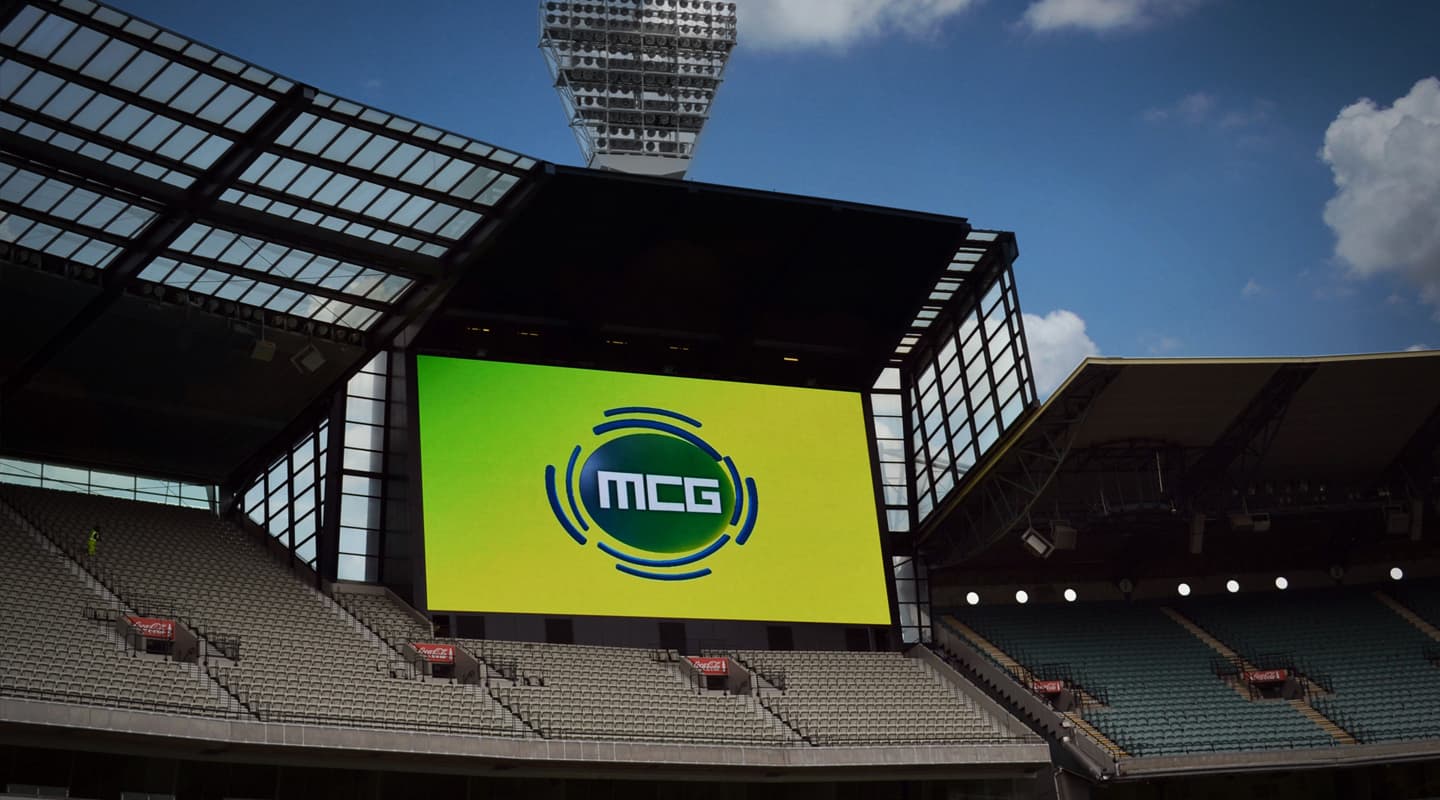
G Whiz
Two XXXL vision boards go into the ‘G’… the hard way.
Story:/ Christopher Holder
Images:/ SDP Media
Everything about the MCG is big. And when you go to replace the ground’s big screens, you’d expect nothing less than one of the biggest cranes in town – 125 tonnes ought to do it. But the terms ‘big crane’ and ‘hallowed turf’ aren’t compatible – one can do all sorts of damage to the other. Furthermore, replacing big screens in one of the busiest stadiums in the world, without seriously throwing out its schedule is a big deal.
What am I getting at? Well, at the risk of losing focus on the state-of-the-art big-screen technology here, this story is really one about logistics. It’s a story where project management, teamwork and long nights of overtime are the heroes rather ingenious system design and space-age technology. It’s the type of job that warrants investing in your own golf cart (more later!).
That said, these are two very tasty vision boards. So let’s do them justice with a quick wrap of the system:
CHAIRMEN OF THE BOARDS
Replacing the MCG’s old Mitsubishi Diamond Vision LED screens are two Daktronics DVX-15HD outdoor video displays. Each screen is 13.2m high by 25.3m wide. Each is comprised of 2484 modules (each module is 365.76mm square) with a pixel pitch of around 15mm. The screen is rated at 7000-9500 nits, boasts 16-bit colour and has a wide horizontal viewing angle of 160°. These are prodigious, magnificent displays. The screens connect via fibre to Daktronics hardware with its Show Control interface taking care of screen layouts — triggering all the heavy lifting done in the Daktronics processor racks.
Each vision board is around three times the size of the previous screens.
SCAFF, CRANES & WINCHES
Jason Kerr, Director of Outdoor Elements, was subcontracted to project manage the install and is now the proud owner of his very own golf cart. Not sure what his handicap is, but Jason invested in the golf cart early in on the job when he realised just how much time he was spending hustling from one end of the MCG to the other working on the two screen positions. “It’s a couple of kilometres round trip between the screens so the golf buggy was invaluable. The concourse has plenty of space, providing it’s one-way traffic. When we had the sparkies coming the other direction it got a bit hair raising.”
Jason was appointed by Daktronics Australia to ‘make it happen’. Daktronics wasn’t the only vendor tendering on the job but proved to have the best handle on the logistics of getting it done in the narrow three-month window and getting it done without the necessity of pulling all the legacy steelwork out.
“The brief was to fit as big a screen as possible. By pulling down the steel fascia work and the old screen-surrounds it opened up the space required. But it wasn’t simply a case of ripping everything out and starting again, we had to be smarter than that. If we had ripped out all of the old infrastructure it would have meant an addition 75 tonnes of steel to pull down. After we reviewed our design, we devised a way to keep the secondary steel structure. In so doing there were a whole host of cost savings, time savings, and the MCG turf would thank us as well.”
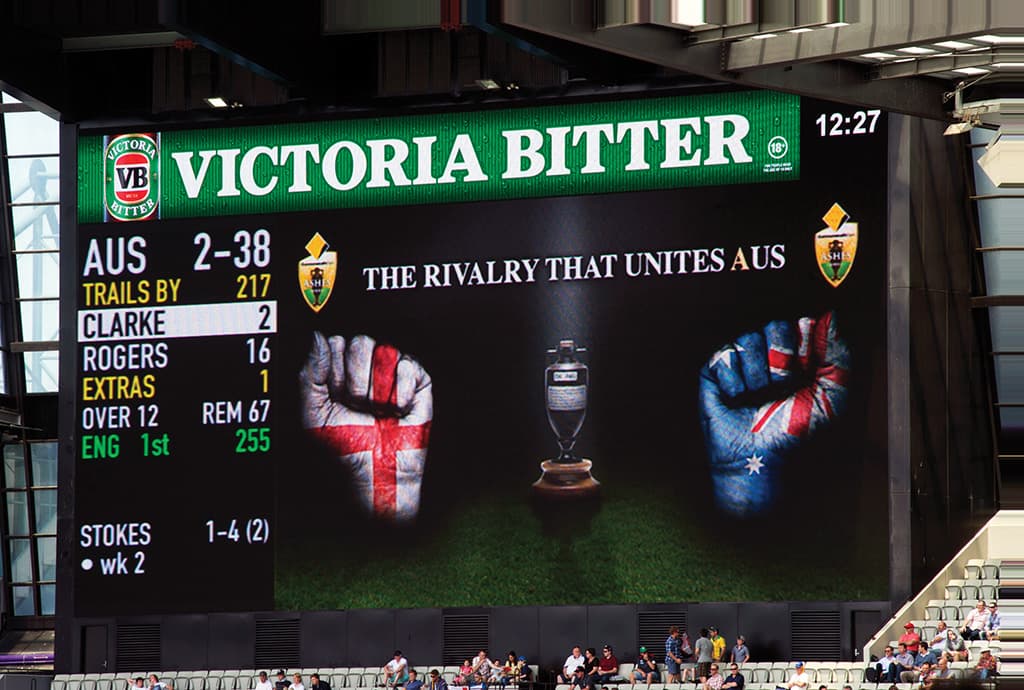
TURF WAR
Pulling out the old screen and supporting steelwork took six weeks out of a 12-week schedule. But this wasn’t wrecking ball work, it was slow and painstaking.
Jason Kerr: “The Monday after the AFL grand final we started stripping out the seating to make space for the demolition, while another crew built a scaffold. One side then the other. It took around six weeks to break down the old screens, the advertising surrounds and the 50 tonnes of steel that had to go. We had to develop tools and materials, and do it in a way that didn’t interrupt the pitch.”
With the structure ready, it was time to truck in the new screen.
Jason Kerr: “Both of the scoreboard positions are completely inaccessible, except via the front. In other words, you can’t bring in a screen from the outside and over the roof; you need to get on the pitch with a crane operating at full extension.”
Ah yes, the 125-tonne crane.
Jason Kerr: “But to bring in a large crane required 3000sqm of ground protection. The protection costs around $100 a square metre. Then you’ve got to fit it. It took 20-odd guys about 8-10 hours to snap all that down. That was a huge logistical nightmare: to find a window that allowed us to get in there. And it couldn’t be in there too long for the sake of the health of the grass.”
With the huge crane in position, the Daktronics vision boards arrived (in bits) in a semi-trailer.
Jason Kerr: “We had the scaffold in position from the demolition and the top level seating removed and we used the whole top area under the screen for the crane to drop off parts.”
The smallest building block is the 365mm x 365mm ‘module’. Daktronics ship the modules around in ‘cabinets’ that can then bolt together to form the dimensions of the screen. For this job Jason prefabricated two cabinets together, and it was these that were craned onto the scaffold decks. Using the rear gantry infrastructure from the old screens the double-cabinet blocks were ready to be used in a giant game of Tetris.
Jason Kerr: “We had an array of winches built into the roof for rope access – we had guys on ropes hanging off the structure like spiders. We also had chain hoists for raising and lowering the cabinets. The setup allowed us to pull up three cabs at a time, which in turn allowed us to motor through the process three times faster because we were no longer using the crane to position the cabinets.”
Some 60 ‘cabinets’ comprise each screen, with the installation starting from the bottom/middle to ensure perfect alignment and then rows of cabinet are installed until the top row was complete. Sounds a breeze, but with millimetre tolerances to ensure a seamless display this was by no means a job for hi-viz grunts on 451 visas – it was a highly skilled, precision operation.
“”
We have hundreds of displays that have been linked to IPTV and we’re in the process of rolling out hundreds more, again, all linked
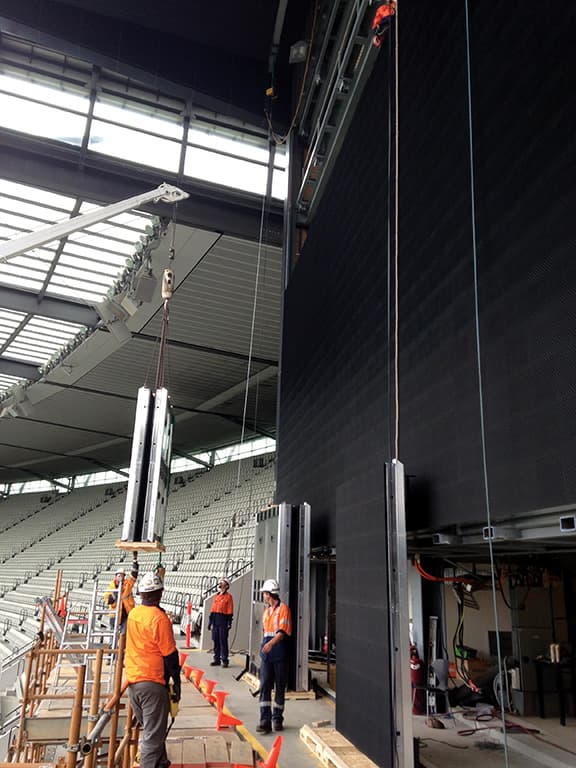
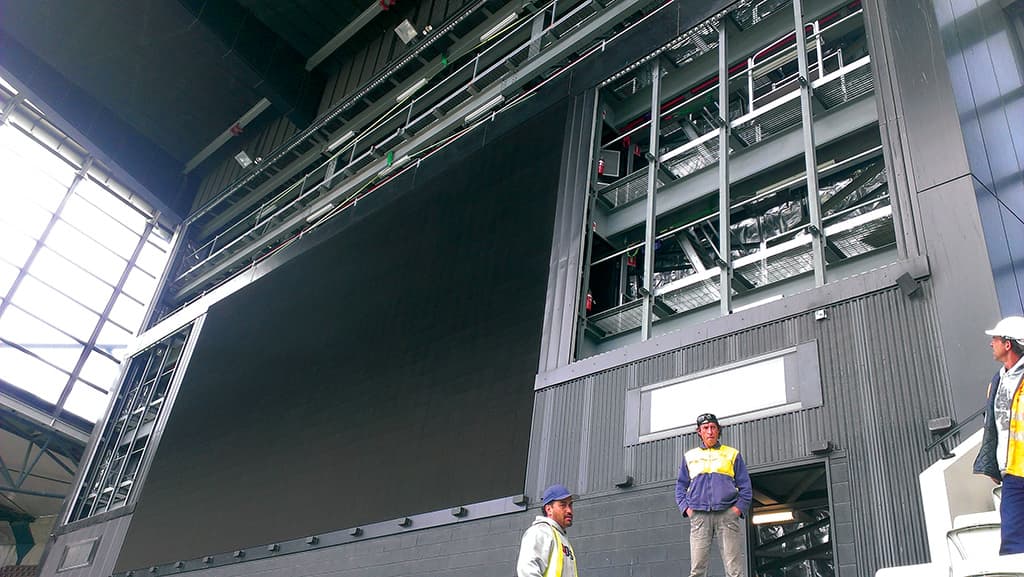
BEHIND THE SCENES
Stepping through a door under a big screen takes you into a large, contained space. In the days of the old screens, it was a room packed with parts and processing that required air conditioning during operation. With all that cleared out for the new vision board, you have enough room for some backyard cricket. The gantry behind the vision board ensures easy access to any level of screens for maintenance.
Seeing how the big screen is pieced together, it really does appear to be simplicity itself. The vision is carried from the control room via the primary and redundant fibres. Those connections plug into the main processor and then network cables interlink modules (using a Daktronics proprietary signal protocol) in a daisychain configuration. The display signal is bi-directional, bringing another level of redundancy. If a module goes down, it can be hot-swapped without impacting the rest of the display.
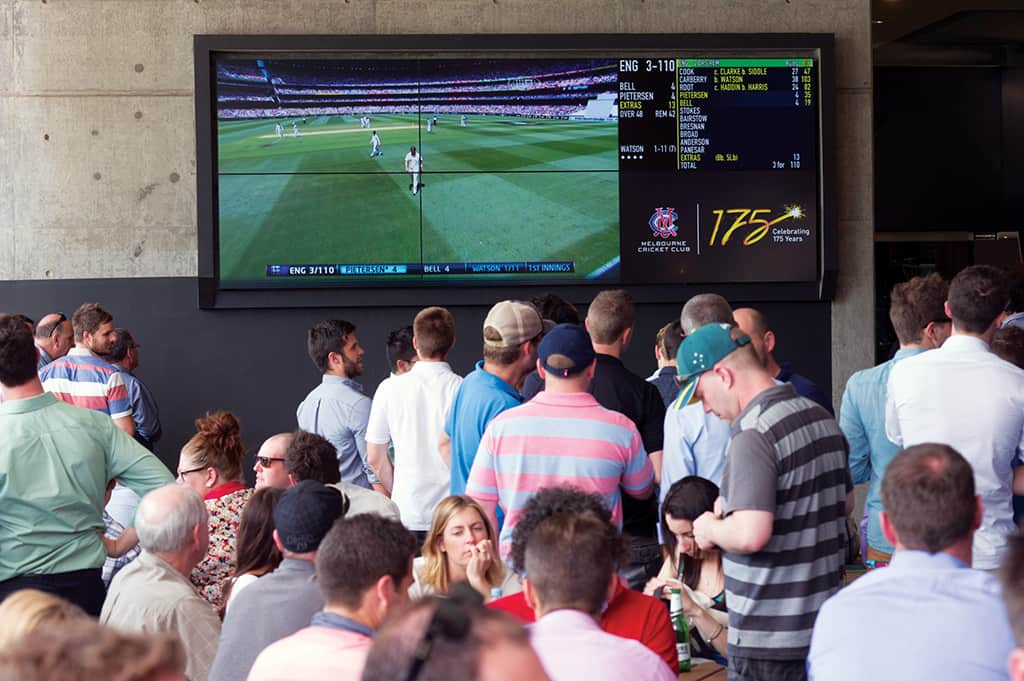
LOOKING AT THE BIGGER PICTURE
The installation may have been achieved without an hour to lose, but there was nothing precipitous in the manner in which these screens were chosen. MCC management took three years to make its decision after plenty of due diligence. In part, the methodical nature of the process is down to the fact the vision boards are only a part (albeit a multi-million dollar part) of a much larger ‘Smart Stadium’ strategy. Talking to the MCC’s GM of Commercial Operations, Lisa Trainor, you get a sense of just how large the scope of this project is. “We have hundreds of displays that have been linked to IPTV and we’re in the process of rolling out hundreds more, again, all linked. They’ll be standalone screens, ‘gladiator’ video walls [3 x 2 multi-screen arrays, as pictured], projections, and LED on the parapets [the hoarding fascia boards facing the pitch]. You’ll walk into the bowl on a Richmond home game and see that tribal yellow and black everywhere — you’ll know you’re at a Richmond home game. The next day you’ll know you’re at a Magpies game, and then Demons.”
Being a North Melbourne supporter, all that fills me with a certain amount of dread… but I take the broader point: the MCG is positioning itself as a world-class sporting venue where AV plays a crucial role in giving fans the best possible game-day experience.
NERVES CENTRE
After touring the ‘back end’ of the vision board we dropped back into the control room. It was matchday for a 20/20 international cricket game and the room was buzzing. Sam Pemberton, who leads the Team Epic (MCG-contracted technical) team was still coming to grips with the implications of all those extra pixels, especially given the control room is still a standard definition facility.
“We’re an SD room with HD-capable screens, so there’s some signal conversion required,” noted Sam. “We’ll be making the move to HD soon. Regardless, you can instantly see just how good the new vision boards are looking.”
There are a few philosophical tenets that are becoming obvious about how the extra screen real estate will be exploited. The MCC management are making good use of the extra ‘canvas’ by providing stadium audiences with additional info, rather than everything just being commensurately larger. This means that cricket crowds will be seeing, for the very first time, a full batting and bowling card. And even though instant replays are 2.3-times larger than before, the Daktronics vision boards have room to spare for crucial score details. On a bash ’n’ dash evening of 20/20… not so important, but for the Boxing Day test, packed with cricket loving stats tragics, the new vision boards were a revelation.
But, let’s be honest, the real action is the AFL. And as AV goes to press, the new season is upon us. The AFL, in concert with the MCC, will be exploring the screens’ possibilities. It really is a case of the technology ‘tail’ wagging the media content ‘dog’, but I don’t hear anyone complaining.
PROJECT CREDITS
Daktronics: (02) 9453 4600 or www.daktronics.com
Outdoor Elements: (03) 9394 1111 or www.oel.com.au

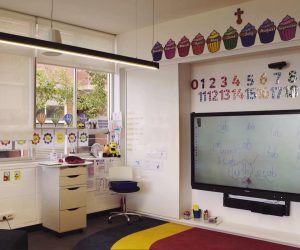

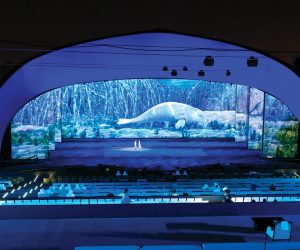
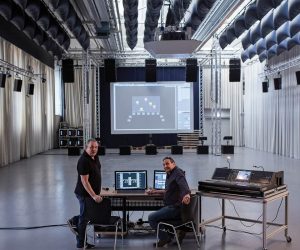
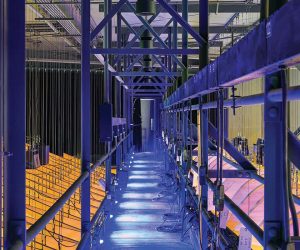
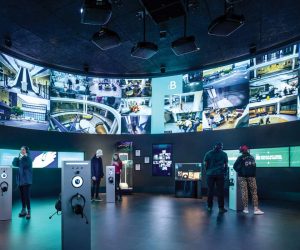





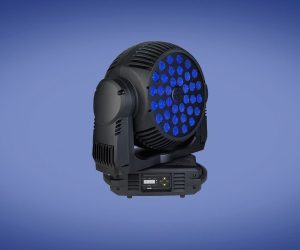


RESPONSES